The Good God in the Detail
In a letter addressed to the German philologist Johannes Geffcken on 16 January 1926, Aby Warburg recalls the opening speech for the first seminar he held at the University of Hamburg:
I told my young comrades-in-arms that I was pleased to have to point out with two principles what they had to expect from the Warburg Library of Cultural Sciences and from me: 1. ‘we go in search of our ignorance and beat it – with the help of our friends – where we find it’ and 2. The good God is in the detail. (Letter to Johannes Geffcken, January 16, 1926, in Mastroianni 2000, 416. Author’s translation).
If it is true that God lurks in the details, it is precisely on the details that a scholar should focus, to grasp what the overall view fails to do. The aim of this contribution is to argue how the zoom – considered here as the act of extrapolation and display of details from a whole image – was used by Warburg as a hermeneutic device in the Mnemosyne Atlas.
Enthusiasms and Failures of a New Technique
A first issue must be kept in mind when attempting to theorize the design methodologies of the Atlas: at the start of the twentieth century, gathering photographs (and their manipulations) was not such an obvious operation. While the circulation and availability of images at that time set a certain degree of limits, the Hamburg scholar always expressed great confidence in the use of new technologies and new means for scientific dissemination, publications, seminars, and lectures. For instance, we read in his introduction to Art of Portraiture and the Florentine Bourgeoisie (1902) how the progress of photography has enabled the advancement of his research, starting with the themes introduced by Burckhardt’s Beitrage zur Kunstgeschichte von Italien:
A stay of some years in Florence, researches in the archive there, the progress of photography, and also the local and chronological limitation of the topic, have emboldened me to publish, in the present paper, a supplement to Burckhardt’s essay (Warburg, Renewal, 186).
In the same essay, we read these words regarding the profile of Lorenzo de’ Medici in Ghirlandaio’s fresco Approvazione della regola francescana:
Although the work has long been known to art history, no one has yet performed the simple, obvious duty of having a large-scale detail photograph taken, or at least subjecting the image to a thorough scrutiny (Warburg, Renewal, 191).
Warburg considers the use of detailed photographs as an “obvious duty” for scholars: a practical aspect that should not be undervalued in their approach to cultural studies. This comes with no surprise if we consider the restless commitment engaged by Warburg with photographers throughout his life. Let us consider, for instance, the partnership established with Alinari, witnessed by Warburg in a note to Art of Portraiture:
The details reproduced as figures 26, 27, 29, and 32 were taken for the first time, at my request, by Fratelli Alinari. Figure 24 is from an existing photograph by Fratelli Alinari (Warburg, Renewal, 217, n.13).
Commissions to Fratelli Alinari are documented over a period of 30 years, along with requests to other photographers based in the places of interest for Warburg’s research. Black and white photography, furthermore, represents for the scholar some sort of “grisaille” that “vereinheitlicht radikal ihre Gegenstände und neutralisiert ihre traditionellen ästhetischen Kategorien” (Forster 1995, 193) [“radically unify the objects and neutralise their traditional aesthetic categories” (Author’s translation)]. About the interest in the use of this tool, we read in Forster:
Bereits vor der Jahrhundertwende waren Montage und trompe l’œil Bilder als Randerscheinungen in Amerika und in Europa entstanden. Seit den zwanziger Jahren gehörte die Fotomontage – sei es in der Anhäufung von Bildern nach dem Muster illustrierter Zeitungen, sei es verfremdend in der surrealistischen und politischen Collage – zu den zentralen künstlerischen Verfahren überhaupt (Forster 1995, 190).
[Even before the turn of the century, montage and trompe l’œil images had emerged as marginal phenomena in America and in Europe. From the 1920s onwards, photomontage – whether in the accumulation of images along the lines of illustrated newspapers, or alienated in surrealist and political collage – was one of the central artistic processes in general (Author’s translation)].
The new study tools offered by the latest methods for image production were widely used: from the use of detail in the attributionalism of Morelli to Duchenne de Boulogne studying the Laocoön, which, according to Philippe Alain Michaud could be considered “not only a montaged figure but a figure of montage” (Michaud [1998] 2004, 286). Despite the enthusiastic faith in this medium, however, it is not just the detail that Warburg bases his epistemological method, nor on the outputs of the photographic device. As Kurt Forster writes:
Während Warburg also einerseits dem historisierenden Sog der Medien nicht widerstand, verfolgte er andererseits ein Ideal, das er Verselbständigung des Bildes - und damit der Verabsolutierung seiner Magie - entgegentrat (Forster 1995, 196).
[Thus, while Warburg did not resist the historicising pull of the media on the one hand, on the other he pursued an ideal that countered the independence of the image – and thus the absolutisation of its magic (Author’s translation)].
Warburg, nevertheless, went further in the aim of a discipline no longer based on the aesthetic impressions of connoisseurs, “but on the concreteness of the detail that carries the formal meaning or the detail pregnant with meaning” (Seminario Mnemosyne 2001, 35. For an updated version of the essay, see Seminario Mnemosyne 2016a). As we read in a letter addressed to the German art historian Adolph Goldschmidt on 9 August 1903:
The connoisseurs and ‘attributionists’, for they are professional admirers, desirous of protecting the peculiar characteristics of their hero either through delimitation or through extension in order to understand him as a logically coherent organism: Bayersdorfer, Bode, Morelli, Venturi, Berenson, and the whole nosey tribe [...] hero-worshippers, but in their ultimate derivations they are only inspired by the temperament of a gourmand. The neutrally cool form of estimation happens to be the original form of enthusiasm peculiar to the propertied classes, the collector and his circle (Gombrich 1970, 147).
Zoom: What is it?
It is not the ‘peculiar characteristics’ that interested Warburg when he used minutiae in his studies. The elusive god hiding in the detail is not meant to be a quiet guide for identification, but rather an unpredictable demon, darting from work to work, unconcerned with authorship, mouldable with the spirit of the times. At this point, a few questions could be asked about the matter:
1) What exactly is meant by ‘zoom’ in the case of the Bilderatlas?
2) What is the consistency of the use of this technique?
3) Can one identify different types of ‘zooms’ with different semantic purposes?
‘To zoom’ is a verb that became widespread in the late nineteenth century: ‘to quickly move closer’ as it refers to a specific aviation sense. Around 1900, the first zoom lenses were patented, thus the term was borrowed into the photographic and film lexicon – up to the current definition, according to the Cambridge English Dictionary: “to adjust a camera to make a person or thing being photographed appear larger or closer”. This contribution shifts the notion of ‘zooming’ from the lexicon linked to the use of lenses in photography or cinema to a metaphorical sense of approaching the detail. Therefore, ‘zooming’ is to be considered here as an editing technique, found in some panels of the Mnemosyne Atlas: the detail from a picture in the panel is enlarged and juxtaposed with other images in the same panel. The main effect of this arrangement is the isolation of figures that, being functional to the subject matter, need a formal autonomy, regardless of the context from which they come. By adopting the fundamental theorisation on ‘detail’ that Omar Calabrese offered us in L’età neobarocca, where we read:
‘Dettaglio’ viene dal francese rinascimentale (e a sua volta ovviamente dal latino) ‘de-tail’, cioè ‘tagliare da’. Esso presuppone pertanto un soggetto che ‘taglia’ un oggetto. [...] La preposizione ‘da’ implica la precedenza di uno stato anteriore a quello del taglio, e altresì la provenienza dell’elemento tagliato da un insieme integro. [...] Una seconda riflessione riguarda il valore da attribuire al prefisso ‘-de’. La particella, infatti, non solo manifesta una anteriorità e una origine del dettaglio, ma illustra anche la natura dell’operazione. Il dettaglio, insomma, viene ‘definito’, cioè reso percepibile a partire dall’intero e dall’operazione di taglio. Solo l’intero e la sostanza dell’operazione permettono infatti la definizione del dettaglio, cioè il gesto di messa in rilievo motivata dell’elemento rispetto al tutto cui appartiene. Detto in altri termini: al dettaglio ci si avvicina per mezzo di un precedente avvicinamento al suo intero; e si percepisce la forma del dettaglio finché questa rimane in relazione percettibile col suo intero (Calabrese [1987] 1989, 75-76).
[‘Detail’ comes from Renaissance French (and therefore, of course, from Latin) ‘de-tail’, i.e. ‘to cut from’. It therefore presupposes a subject that ‘cuts’ an object. [...] The preposition ‘de’ implies the existence of a state prior to the cutting, and also the origin of the cut element from an intact whole. [...] A second reflection concerns the value to be attributed to the prefix ‘-de’. The particle, in fact, not only manifests an anteriority and origin of the detail, but also illustrates the nature of the operation. The detail, in short, is ‘defined’, that is, made perceptible starting from the whole and from the cutting operation. In fact, only the whole and the substance of the operation allow the definition of the detail, that is, the gesture of motivated highlighting of the element with respect to the whole to which it belongs. In other words: the detail is approached by means of a previous approach to its whole; and the form of the detail is perceived as long as it remains in a perceptible relationship with its whole (Author’s translation)].
This definition could help us in trying to justify the presence of the whole image within the panel where its detail is also displayed. However, Calabrese introduces another semantic device:
Del tutto diversa è l’etimologia di ‘framment’, che deriva dal latino ‘frangere’, cioè ‘rompere’. [...] Il frammento, invece, diversamente dal dettaglio, pur essendo parte di un testo preesistente (intero), non ne contempla la compresenza. Qui l’intero è in absentia (Calabrese [1987] 1989, 77-78).
[Entirely different is the etymology of ‘fragment’, which derives from the Latin ‘frangere’, i.e. 'to break'. [...] Unlike the detail, the fragment, although part of a previous whole, does not contemplate its presence in order to be defined. On the contrary: the whole is in absentia (Author’s translation)].
By abstracting the bicephalic nature of detail versus fragment, used by Calabrese, we could try to apply this definition as a key to studying the Atlas. Is it really possible to apply this dichotomy to the black screen of Mnemosyne? Is, perhaps, the semantic power of the Mnemosyne Atlas that of transforming ‘detail’ into ‘fragment’, revealing the tragic character of a rupture – the disruption between the re-emersion from the Ancient and its wider pictorial context? The isolation of a fulcrum from a work of art firstly seems to stretch out into a horizontal movement, while the sensation that invades us, as we look at the panels, is that of the vertical movement of a catabasis into the deep seas of figuration. Calabrese’s definition of ‘detail’ is therefore challanged by the processes that Warburg performs on images: these are acts of fragmentations whose results are not called to dialogue with their own origins but are rather energetically attracted to other images, striving for a more complex unity. The juxtaposition of images taken from different sources generates something new, something whose power would not be produced by the single image.
The methodology used for this contribution has been drawn, as a starting point, by searching the keyword ‘detail’ through all the captions in the Atlas. This has been possible thanks to the index of materials published by Seminario Mnemosyne in “Engramma” (Seminario Mnemosyne 2016), a further confirmation of the importance of the use of captions as a studying device of the Bilderatlas, and a validation of the possibility to examine it with the methodology of a “scholar without eyes” (Pasquali [1930] 2022, 39). The nature of this quest goes further on from the real to the metaphorical: the use of detail in the construction of the Atlas proved to be synecdotal regarding Warburg's epistemological method. The recurrence has been detected in seventeen panels and surely with a margin for errors and implementations that will be addressed in subsequent studies. Furthermore, it should also be noted that this editing technique is also occasionally present, in the two earlier versions of the Atlas, dating from 1928, which we have not included because of their embryonic nature compared to the 1929 version (the so-called final one).
‘Zoom’ in Mnemosyne: All the Occurrences
At this preliminary stage, the attempt of this study, is to gather all the occurrences and to provide an example of a method that requires further and intensive work on the individual images of the Atlas. Whenever possible, an attempt has been made to cross-reference Mnemosyne panels with the corpus of Warburg's published writings. Warburg’s precise textual descriptions of specific artifacts are effective tools in deciphering the value of the images in the panels’ economy. The possibility of crossing these two universes is an extremely important tool for the theorisation of Aby Warburg’s compositional strategies, thus sealing the “alchemical marriage” conceived by Kurt Forster:
Susceptible though he was to the attraction of visual media, Warburg simultaneously pursued an ideal that ran counter to the autonomy of the image – and of its magic. This ideal was that of congruence between visual material and conceptual definition. Verbal formulas of invocation made the affinities between image and concept into an alchemical marriage (Forster 1999, 49).
Panel 27

Detail from Mnemosyne Atlas, Panel 27, Warburg Institute Archive, London.
27_2 | Francesco del Cossa, The April sky with the triumph of Venus and the decans of the month, fresco, 1469-1470, Ferrara, Palazzo Schifanoia, Sala dei Mesi.
27_3 | Francesco del Cossa, The March sky with the triumph of Minerva and the deans of the month, fresco, 1469-1470, Ferrara, Palazzo Schifanoia, Sala dei Mesi.
27_4 | Francesco del Cossa, The March sky with the triumph of Minerva and her children, detail, fresco, 1469-1470, Ferrara, Palazzo Schifanoia, Sala dei Mesi.
27_6 | Francesco del Cossa, The April sky with Mars chained in front of Venus, detail, 1469-1470, Ferrara, Palazzo Schifanoia, Sala dei Mesi.
In Panel 27, the detail focuses on two of Francesco del Cossa’s frescoes for the Sala dei Mesi in Palazzo Schifanoia in Ferrara. From the fresco depicting the April sky, with the triumph of Pallas Athena and the decans of the month, in the upper right-hand corner of the panel, Warburg ‘extracts’ the upper band, representing the triumph of Pallas Athena and her children, and places an enlargement of it on the panel. This enlargement corresponds with Warburg's description of this part of the fresco in his 1912 lecture Italian Art and International Astrology in Palazzo Schifanoia:
Above, on a triumphal car drawn by unicorns, its hangings fluttering in the breeze, we see the damaged – but clearly identifiable – figure of Pallas Athena, spear in hand, wearing the gorgoneion on her breast. To the left we see Athena’s votaries: physicians, poets, lawyers (who might possibly be identified, on closer study, as contemporary figures from the university of Padua). To the right, by contrast, we find ourselves looking in on a kind of Ferrarese needlework bee. In the foreground are three women knitting; behind them are three weavers at their loom, watched by a cluster of elegant ladies. To believers in astrology, this apparently unremarkable group was a sign of the prediction anciently associated with the subjects of Aries: that anyone born in March, under the sign of the Ram, would show a talent for artistry with wool (Warburg, Renewal, 572).
The same procedure is applied for the fresco depicting the April sky with Aphrodite and the decans of the month (displayed on the panel on the left of the March fresco). Warburg extracts and enlarges a detail of the upper band, isolating the floating chariot on which the goddess proceeds in her triumph, while Ares is kneeling in front of her. This is the same detail that Warburg dwells on in his 1912 essay:
Let us now turn to April, ruled by Taurus and Venus. Skimming the waves in her swan-drawn barge, its draperies flying so bravely in the breeze, this goddess betrays no superficial trace of a Grecian style. At first sight, only her costume, her loose hair, and her garland of roses distinguish her from the inmates of the two Gardens of Love, who pursue their concerns in so worldly a fashion to her left and right. […] Let us now look back at Cossa’s Aphrodite. The garland of red and white roses; the doves that flutter around the goddess as she floats along; Cupid, depicted on his mother’s girdle as he aims his bow and arrows at a loving couple; and above all the three Graces, who are certainly copied from an antique original, prove the artist’s intention of supplying an authentic reconstruction of antiquity (Warburg, Renewal, 573-577).
Panel 28-29
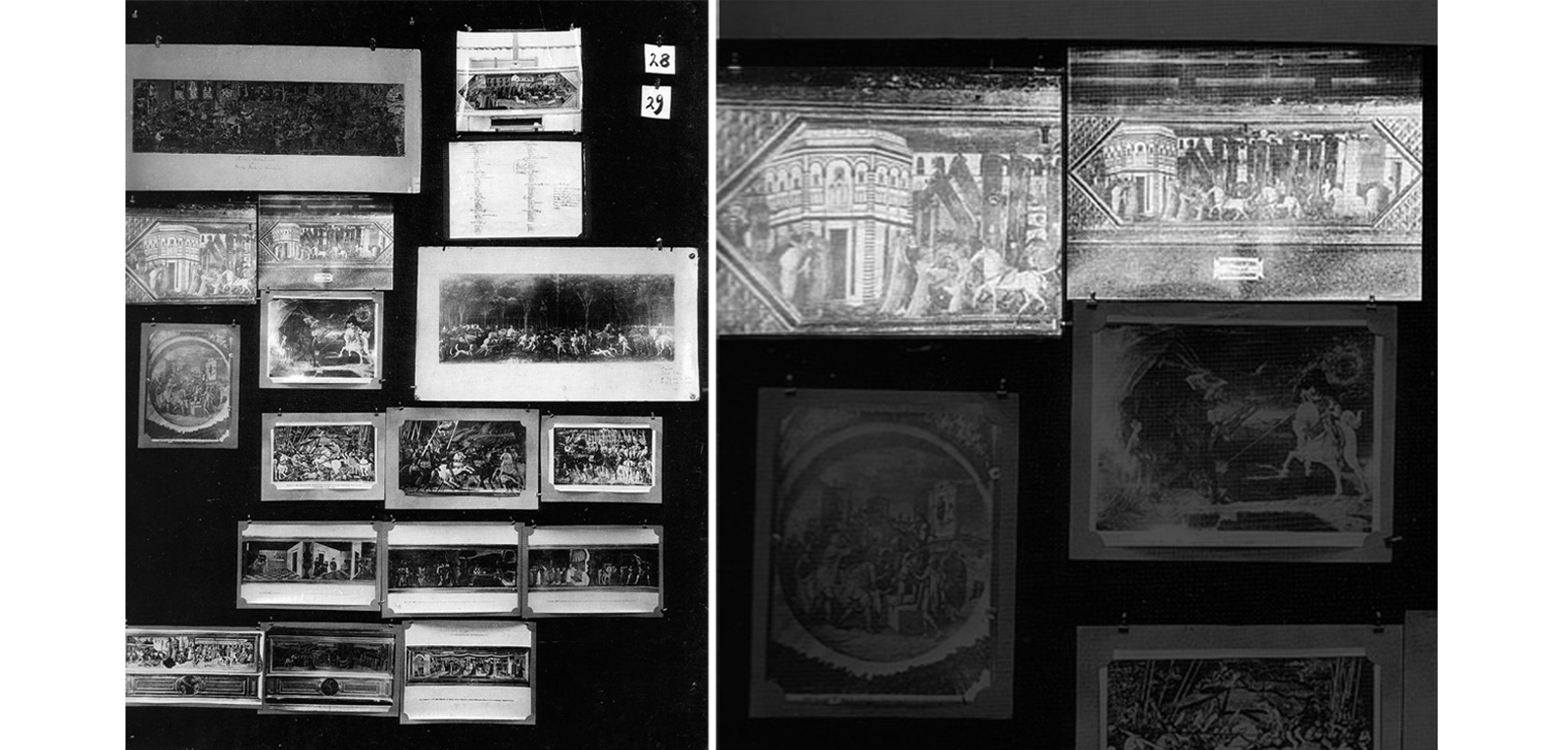
Detail from Mnemosyne Atlas, Panel 28-29, Warburg Institute Archive, London.
28-29_4 | Palio di S. Giovanni, Sellers of antidotes, detail, marriage chest, early fifteenth century, Firenze, Museo Nazionale del Bargello.
28-29_5 | Palio di S. Giovanni, Marriage chest, early fifteenth century, Firenze, Museo Nazionale del Bargello.
In Panel 28-29, whose theme focuses on the daily life represented on chests as a vehicle for the circulation of images and themes from antiquity, Warburg studies the image of a Florentine wedding chest from the early fifteenth century, depicting the Palio di San Giovanni. By ‘zooming’ on its decoration (the photograph of the detail can be seen on the left side to the entire image of the painted chest), the attention is drawn to the scene of the medicine (triaca) sellers: the depiction of a “self-regarding society that presents itself, in all its pleasing detail, in the conversational tone of a court balladeer” (Warburg, Renewal, 282).
Panel 30
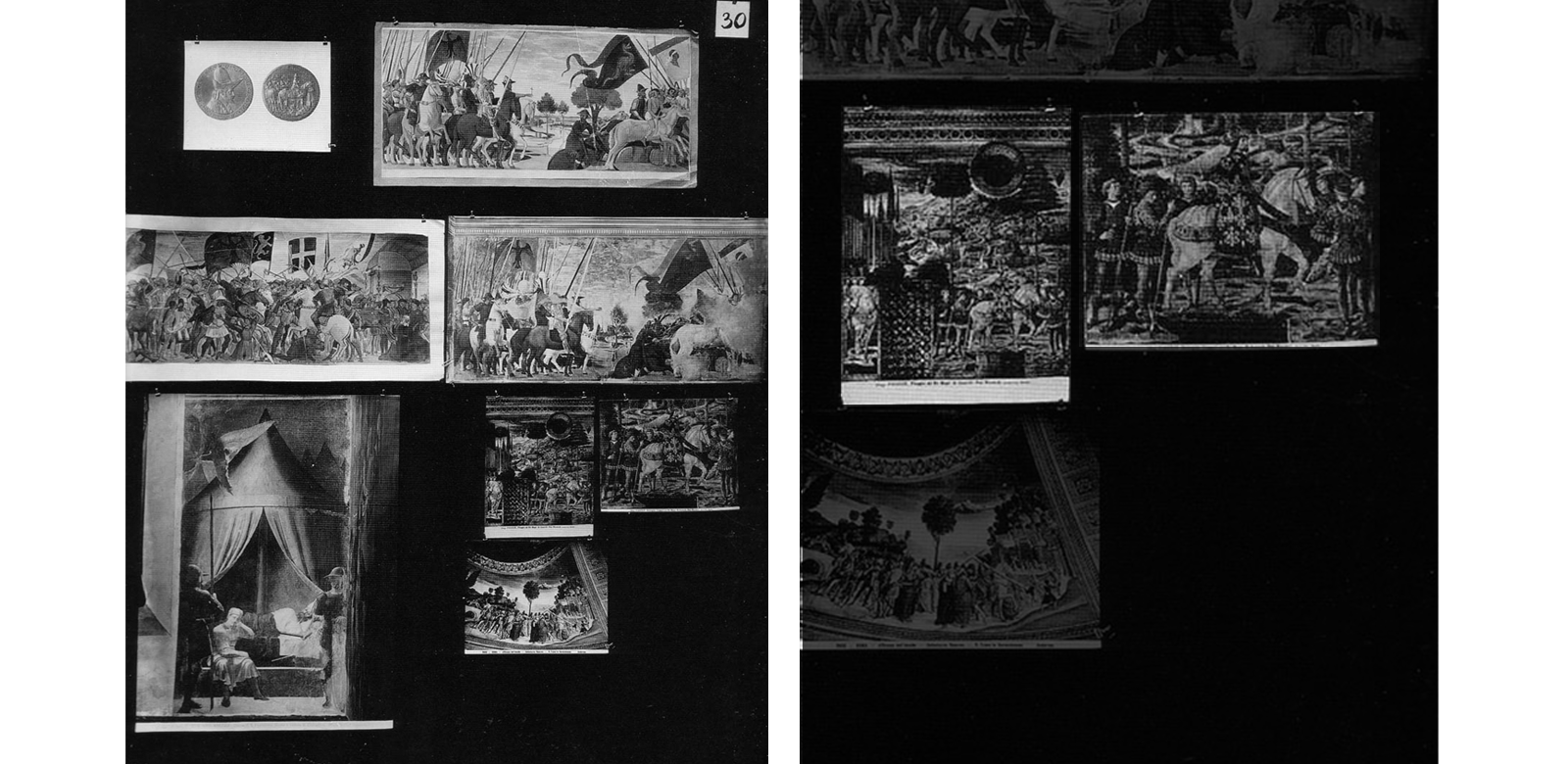
Detail from Mnemosyne Atlas, Panel 30, Warburg Institute Archive, London.
30_5 | Benozzo Gozzoli, Journey of the Three Kings, fresco, 1459-1461, Firenze, Cappella di Palazzo Medici-Riccardi.
30_6 | Benozzo Gozzoli, Giovanni VIII Paleologo as one of the Three Kings, detail, fresco, 1459-1461, Firenze, Cappella di Palazzo Medici-Riccardi.
In an 1893 lecture about Matteo degli Strozzi, the young son of a merchant, Warburg uses this words to describe this latter:
He wore a short purple doublet, and he had just been given a new cloak. We might imagine him as looking like one of the young horsemen who ride with the procession of the Three Kings in Benozzo Gozzoli’s fresco in the Palazzo Riccardi, in Florence (Warburg, Renewal, 264).
The detail of this procession – depicted by Benozzo Gozzoli and affixed in Panel 30, about which Warburg notes: “Monumentalisierung und Distanzierung. Dazu Gozzoli. Paleologus” – makes us focus here on the figure of Giovanni VIII Paleologo as one of the Three Kings. Crossing the visual source (the detail) with the textual one (the simile) could be a good hermeneutical weapon for studying the concept of “monumentalisation and distancing”.
Panel 39

Detail from Mnemosyne Atlas, Panel 39, Warburg Institute Archive, London.
39_11a | Sandro Botticelli, Primavera (according to Warburg The Realm of Venus), tempera on table, 1477-1482, Firenze, Uffizi.
39_11b | Sandro Botticelli, Chloris, detail from Primavera, tempera on table, 1477-1482, Firenze, Uffizi.
39_11c | Sandro Botticelli, Chloris, detail from Primavera, tempera on table, 1477-1482, Firenze, Uffizi.
Panel 39 of the Bilderatlas gathers the themes of love and metamorphosis, where “Botticelli’s mythological allegories are examples of the introduction of the all’antica style in early Renaissance art” (Mnemosyne Atlas 39, “Engramma”). This panel must be considered a valuable object of study, as it has a direct correspondence with a text written by Warburg, Sandro Botticelli’s Birth of Venus and Spring (1893). The two figures, Chloris and Zephyrus, are taken away from Sandro Botticelli’s Primavera because they detain a particular autonomy, expressed by their pose, ascribable to a scene of erotic pursuit and allow us a precise comparison with the literary sources, either from Antiquity or Florentine Renaissance, used by the artist.
Panel 43

Detail from Mnemosyne Atlas, Panel 43, Warburg Institute Archive, London.
43_7 | Domenico Ghirlandaio, Approval of the Franciscan Rule by Pope Onorio III, fresco, 1479-1486, Firenze, Chiesa di Santa Trinita, Cappella Sassetti.
43_8 | Domenico Ghirlandaio, Approval of the Franciscan Rule by Pope Onorio III, portraits of Luigi Pulci and Matteo Franco, detail, fresco, 1479-1486, Firenze, Chiesa di Santa Trinita, Cappella Sassetti.
43_9 | Domenico Ghirlandaio, Approval of the Franciscan Rule by Pope Onorio III, portraits of Piero and Giovanni de’ Medici, detail, fresco, 1479-1486, Firenze, Chiesa di Santa Trinita, Cappella Sassetti.
43_10 | Domenico Ghirlandaio, Approval of the Franciscan Rule by Pope Onorio III, portraits of Angelo Poliziano and Giuliano de’ Medici, detail, fresco, 1479-1486, Firenze, Chiesa di Santa Trinita, Cappella Sassetti.
43_11 | Domenico Ghirlandaio, Approval of the Franciscan Rule by Pope Onorio III, portraits of Lorenzo de’ Medici and Francesco Sassetti, detail, fresco, 1479-1486, Firenze, Chiesa di Santa Trinita, Cappella Sassetti.
In Mnemosyne Atlas, Panel 43, the device is functional to the text. The enlargements applied to the panel, taken from the Cappella Sassetti’s fresco Approvazione della regola francescana, faithfully follow 1902 essay The Art of Portraiture and the Florentine Bourgeoisie, where Warburg guides the reader to the recognition of the single characters depicted in the fresco by Domenico Ghirlandaio. Circumstantial pieces of evidence and interest in the physiognomy of the figures make it possible to open the discourse to the entire cultural milieu of late fifteenth-century Florence. As in the essay the characters are described and recognized, so in the panel, below the overall photograph of the fresco, there are four details depicting the eight protagonists of the Medicean procession. The art of portraiture insinuates itself with vital overbearingness into the sacred representation and, thus, the celebration of power is accentuated by the immediate recognisability of its actors. Isolating each figure is the synthesis of this cultural and figurative process: the narrative composition is subordinate to the desire to portray the lords of the Medici court.
Panel 45
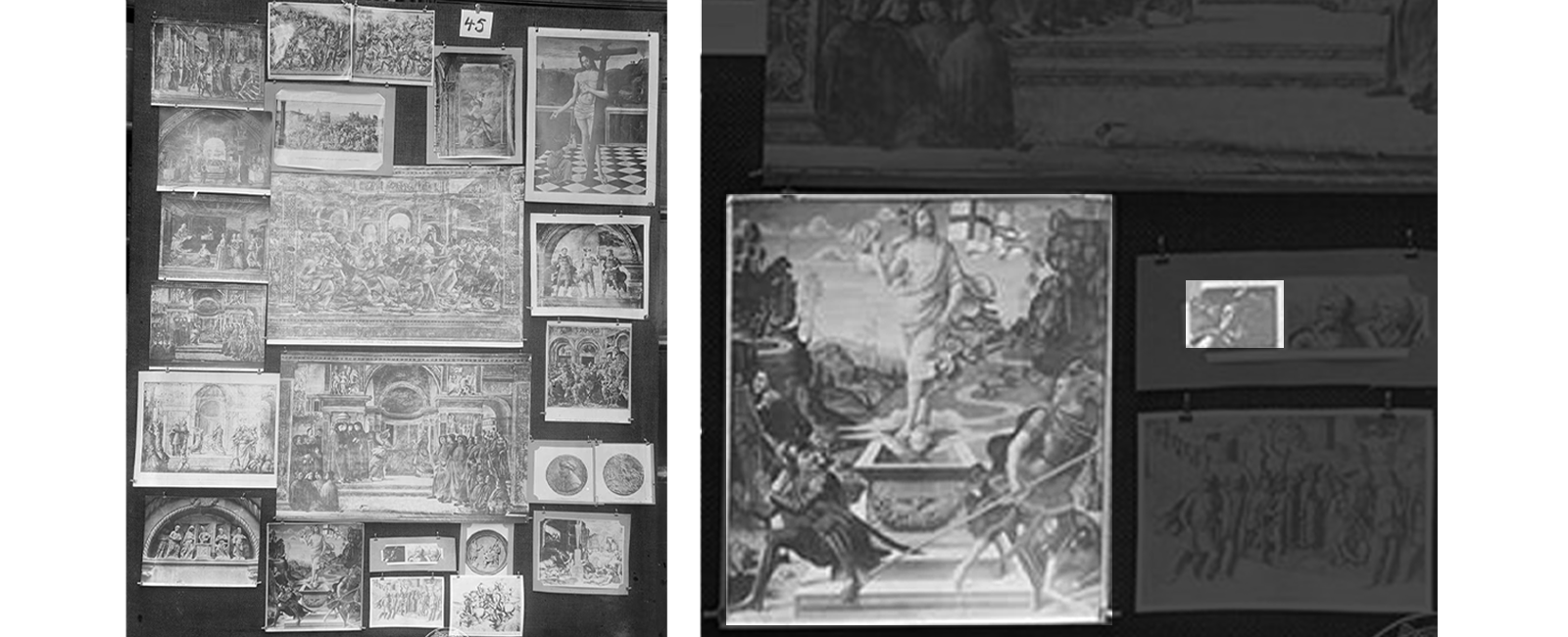
Detail from Mnemosyne Atlas, Panel 45, Warburg Institute Archive, London.
45_16 | Davide and Benedetto Ghirlandaio (on Domenico Ghirlandaio’s drawing), Resurrection, tempera on table, post 1494, Berlin, Staatliche Museen, Gemäldegalerie.
45_17a | Davide and Benedetto Ghirlandaio (on Domenico Ghirlandaio’s drawing), Head of a fleeing guard, Resurrection, tempera on table, painting, post 1494, Berlin, Staatliche Museen, Gemäldegalerie.
45_17b | Bottega di Domenico Ghirlandaio, Head of two Dacians fleeing from the Romans, detail, ink drawing, 1490 ca., Escorial, Biblioteca del Monasterio de San Lorenzo el Real, Cod. Escurialensis 28-II-12, fol. 63.
In Panel 45, the ‘zoom’ drives our attention to the ancient model in Renaissance painting through the assimilation of pathetic formulae as engrams for the expression of human emotion. The Roman soldier who, in Ghirlandaios’ Resurrection, flees in fear before the miracle of Christ defeating death, extrapolated from his pictorial context, and juxtaposed with the drawing of a relief of Trajan’s Column from Codex Escurialensis depicting two Dacians running away from the Romans, assumes the same posture as the fleeing barbarian. The detail of the guards is, therefore, ‘taken away’ from the photograph of Ghirlandaio’s Resurrection and displayed next to the drawings of the two barbarians, making their iconographic descent clear. As Warburg writes in 1914 in The Emergence of the Antique as a Stylistic Ideal in Early Renaissance Painting:
The central painting of the altarpiece that Ghirlandaio and his brothers made for the Tornabuoni chapel shows Christ’s Resurrection on the reverse side, and the exemplary pathos formula of Antiquity penetrates here, even informing the expression of tragic horror. The Saviour, rising up from the grave, has plunged the three pagan guards in fear and alarm. One of them, raising his shield over his bearded head as if to defend himself, is fleeing, his robe fluttering in the wind. […] Ghirlandaio’s sketchbook reveals the model: the fleeing barbarian from Trajan’s Column who, just like the guard in terms of his physiognomy, his posture and the movement of his robe, is rushing away from the troops of Trajan. In terms of the momentary expression of fear on his face, with its furrowed eyebrows and open mouth, and even in terms of the ornamental wings on his helmet, the guard rushing off to the left points towards his model, admittedly not quite attained, namely, the head of the screaming winged Medusa crying out, which he carries with supreme effort on his shield as his coat of arms (Warburg [1914] 2001, 24).
Panel 46
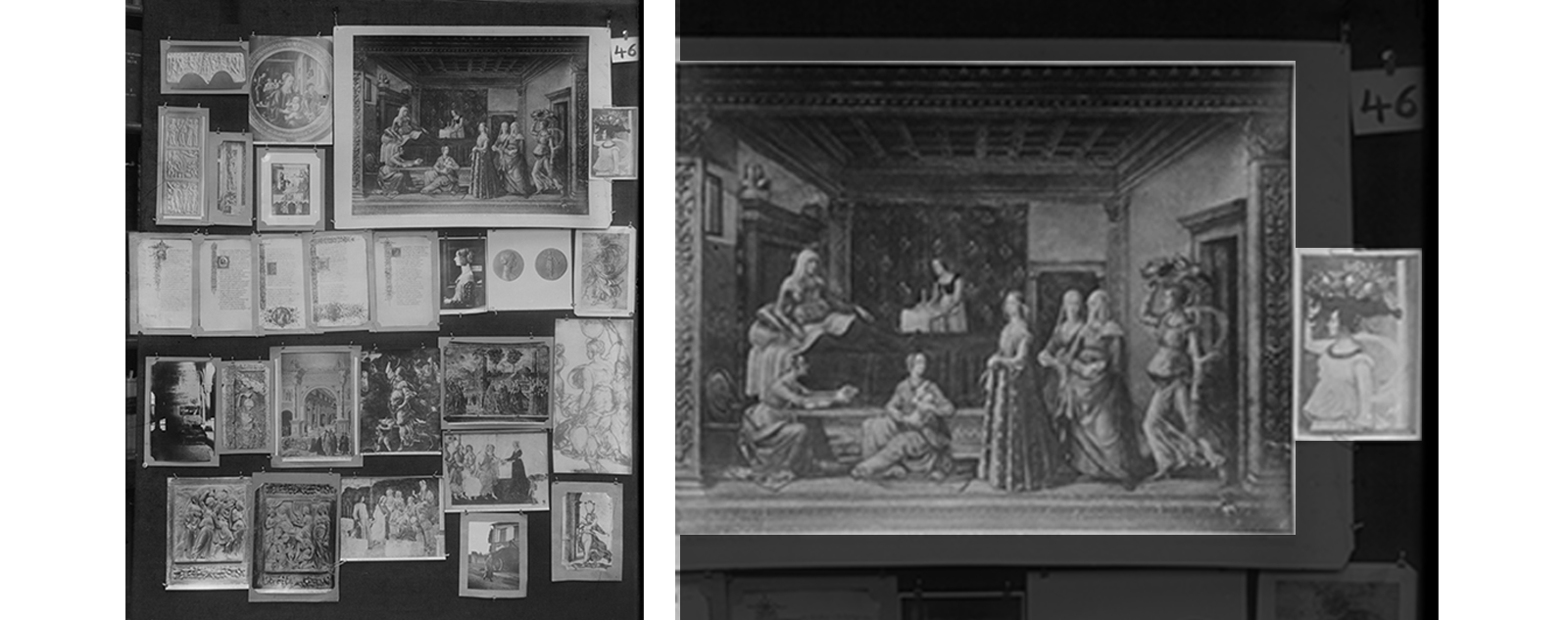
Detail from the Mnemosyne Atlas, Panel 46, Warburg Institute Archive, London.
46_3 | Domenico Ghirlandaio, Birth of Saint John the Baptist, fresco, 1486, Firenze, Chiesa di Santa Maria Novella, Cappella Tornabuoni.
46_7 | Ghirlandaio’s workshop, Fruit bearer, copy of the detail from Birth of Saint John the Baptist, Firenze, Chiesa di Santa Maria Novella, Cappella Tornabuoni, Pisa, Museo Civico.
In Panel 46, dedicated to the Nymph and her stride, Warburg focuses on Ghirlandaio’s fresco Birth of John the Baptist, drawing our attention to the fruit-bearing maiden who is entering the scene. The figure of this Nymph, entering the fresco from the right side, is taken by Warburg and ‘absolutised’ in the figure next to it, in Panel 46. It is an image that, at a first glance, might appear to be an extrapolation of Ghirlandaio’s canephore, while being in fact a workshop copy of the figure, evidence of the subject’s diffusion in autonomous ways (Seminario Mnemosyne 2021, for an English version see Seminario Mnemosyne 2000).
Panel 47
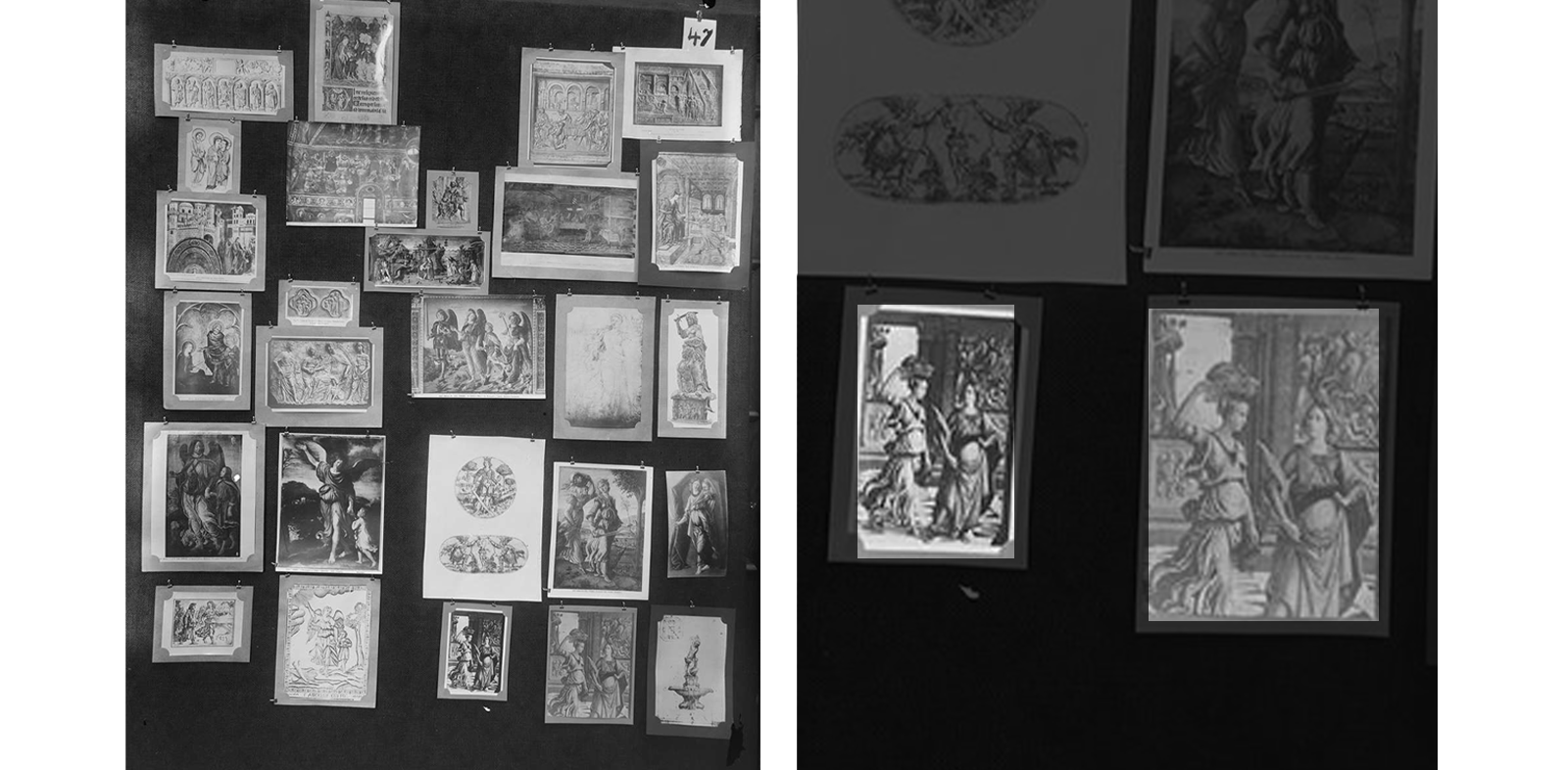
Detail from the Mnemosyne Atlas, Panel 47, Warburg Institute Archive, London.
47_25 | Scuola del Ghirlandaio, Judith with the Head of Holofernes, oil on table, 1489, Berlin, Staatliche Museen, Gemäldegalerie.
47_25b | Scuola del Ghirlandaio, Judith with the Head of Holofernes, detail, oil on table, 1489, Berlin, Staatliche Museen, Gemäldegalerie.
Panel 47 presents two photographs of the same subject: Domenico Ghirlandaio’s Judith with the Head of Holofernes. This uneven duplication – the second photo, affixed to the right of the first one, has a different cut – raises questions about the meaning of the montage. Is it a placeholder? It might be plausible to imagine that Warburg wanted to place something else. Possibly a picture with similarly posed figures, therefore he left a memento to, perhaps, commission another photograph. Alternatively, the double use of Ghirlandaio’s painting might suggest a visual introduction to oxymoronic themes as the Pathosformel of cure and, at the same time, that of victory. Within the painting, it is interesting to note the presence of two distinct characters: Judith who, with her sword, expresses the idea of triumph, and, next to her, a canephore (the basket on her brim bears the macabre gift of John’s head) who, with the drapery of her dress moved by the wind, expresses to the utmost degree the idea of the Nymph. As Warburg writes in 1905:
It is like the dresses of the flying Victories on Roman triumphal arches, or of those dancing maenads, consciously imitated from the antique, who first appeared in the works of Donatello and of Filippo Lippi. Those figures revived the loftier antique style of life in motion, as we find it in the homeward-bound Judith, or in the angelic companion of Tobias, or in the dancing Salome, who emerged on biblical pretexts from the workshops of Pollaiuolo, Verrocchio, Botticelli, and Ghirlandaio, grafting eternal shoots of pagan antiquity onto the withered rootstock of Flemish-influenced bourgeois painting (Warburg, Renewal, 174).
Panel 52
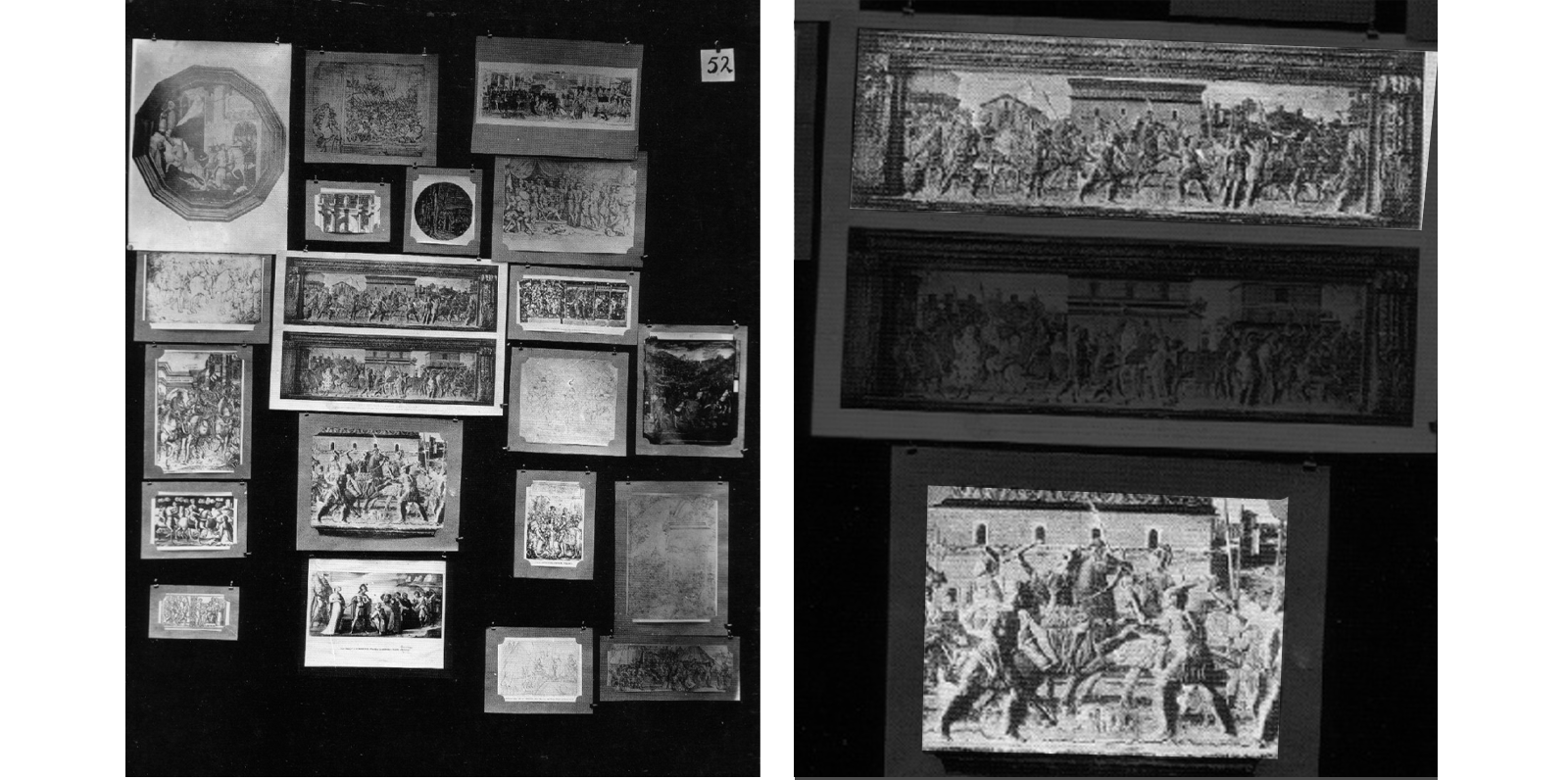
Detail from the Mnemosyne Atlas, Panel 52, Warburg Institute Archive, London.
52_11 Cerchia di Andrea Mantegna, Triumph of the Romans over the Dacians, from The Legend of Trajan, stucco bas-relief, Paola Gonzaga’s marriage chest, Mantova 1477, Klagenfurt, Museum Rudolfinum.
52_13 | Cerchia di Andrea Mantegna, Trajan’s Justice, from The Legend of Trajan, stucco bas-relief, Paola Gonzaga’s marriage chest, Mantova 1477, Klagenfurt, Museum Rudolfinum.
Warburg in Panel 52 focuses his attention on Paola Gonzaga’s wedding chest by Mantegna’s workshop. Underneath the picture of the bas-relief decoration, representing the triumph of the Romans over the Dacians, is affixed a photographic detail of the scene. The image depicted is that of Trajan’s Justice, following the legendary tradition whereby the emperor breaks his horse in front of the supplicant mother whose son has been run over by his soldiers. The enlargement isolates the emperor in front of the woman, separating them from the extended scene of the military procession. The inversion of the energetic sense whereby the imperial pathos – represented to the utmost degree by the depiction of the condottiero in the act of “overwhelming by riding” – becomes, using an overlapping pose, the representation of power restrained by Christian piety (see Centanni’s contribution published in this issue). As Warburg writes in his Einleitung to the Atlas:
[B8] Medieval church discipline, which had experienced a merciless enemy in the form of the deification of the Emperor, would have destroyed a monument like the Arch of Constantine, had it not been possible to preserve the heroic acts of the Emperor Trajan, supported by reliefs added later, under the mantle of Constantine.
Even the Church had managed to lend the self-glorification of the Trajan relief Christian sentiment, by means of a legend that was still alive in Dante. The famous story of the pietà of the Emperor towards a widow who was pleading for justice is probably the subtlest attempt at transforming imperial pathos into Christian piety, through the energetic inversion of its meaning; the Emperor, bursting out of the inner relief, becomes an advocate of justice, and bids his followers halt, because the widow’s child has fallen under the hoofs of a Roman rider (Warburg [1929] 2017).
Panel 54

Detail from Mnemosyne Atlas, Panel 54, Warburg Institute Archive, London.
54_3 | Baldassarre Peruzzi, Astrological and mythological motifs: Eridanius, Jupiter and Taurus, fresco, 1510-1511, Roma, Villa Farnesina, Sala di Galatea.
54_5 | Baldassarre Peruzzi, Astrological and mythological motifs: Eridanius, detail, fresco, 1510-1511, Roma, Villa Farnesina, Sala di Galatea.
In panel 54, there are photos of Baldassarre Peruzzi’s frescoes for the vaults of Sala di Galatea in Villa Farnesina, in which Agostino Chigi’s horoscope is depicted. As we read in Warburg’s 1926 Astrology under Oriental Influence:
In the Farnesina – and this has never previously been remarked upon – Agostino Chigi placed his own horoscope on symbolic display in the room painted by Peruzzi: the gods of antiquity, so casually facing each other, signify conjunctions, and the combination – as the director of the Hamburg observatory, Professor Graff, has kindly demonstrated – even makes it possible to specify 1465 as the year of Chigi’s birth (Warburg, Renewal, 701).
From the image of a vault with astrological and mythological themes affixed to the panel, the detail – which is extracted and affixed below the picture of the entire vault – isolates the figure of the river god Eridanus.
Panel 55
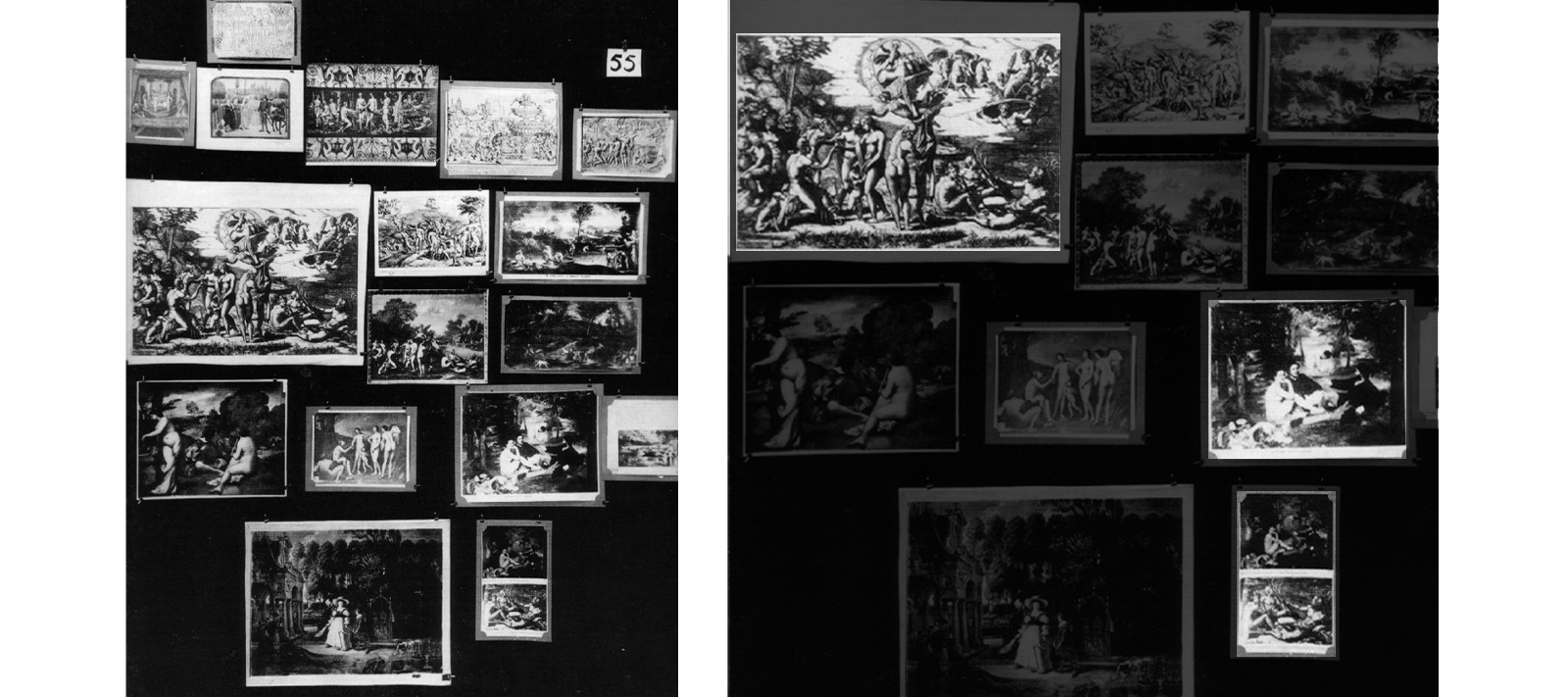
Detail from Mnemosyne Atlas, Panel 55, Warburg Institute Archive, London.
55_7 | Marcantonio Raimondi (from Raphael), The Judgement of Paris, etching on copper, c.1530.
55_14 | Edouard Manet, Déjeuner sur l’erbe, oil on canvas, 1863, Paris, Musée d’Orsay.
55_17 | Edouard Manet, Déjeuner sur l’erbe, detail, oil on canvas, 1863, Paris, Musée d’Orsay.
55_18 | Marcantonio Raimondi (from Raphael), The Judgement of Paris, Seated River God, detail, etching on copper, c.1530.
One of the most relevant examples of the use of details in the architecture of Mnemosyne is Panel 55, focusing on the scene of the Judgment of Paris as an example of the symbolic rise and fall of the gods on earth (“Engramma”, Panel 55). Manet’s Déjeuner sur l’herbe and Marcantonio Raimondi’s Judgement of Paris are both displayed in the panel in their entirety. They are then affixed in the lower right of the plate through the use of extrapolation, which isolates the characters of interest (and their postures). As Warburg writes:
Se adesso proviamo a confrontate le tre figure sdraiate del Déjeuner sur l’herbe con il sarcofago e con l’incisione italiana, l’anello di congiunzione sembra costituito dalla testa rivolta verso lo spettatore della ninfa acquatica di Marcantonio Raimondi. [...] Nella sinfonia a tre voci di Manet questa coscienza dello spettatore, propria dell’incisione italiana, si è chiaramente rafforzata: anche l’uomo accanto alla ninfa francese guarda fuori dal quadro con occhi rigidamente protesi (Warburg [1929] 2019, 42).
[If we now compare the three reclining figures of Le Déjeuner sur l’herbe with the sarcophagus and the Italian engraving, the connecting link is represented by the head turned outwards towards the spectator of Marcantonio’s naiad. [...] In the three-voice symphony of Manet’s scene, this consciousness of the spectator proper to the Italian engraving is clearly reinforced: even the man next to the French nymph looks out of the picture with firmly energetic eyes (Author’s translation)].
The gaze here is both the link between the representations and the exemplification of the energetic inversion process: the skyward gaze of the figure engraved on the Roman sarcophagus becomes, in Raimondi, “la strada lineare di un abbandono senza timore alla bellezza e bontà originaria della natura” (Warburg [1929] 2019, 41) [“the symbol of a fearless abandonment to the primal goodness and beauty of nature” (Author’s translation)]. Thus, it represents the prefiguring function for the modern feeling of fusion between man and nature, depicted by Manet, in which the intensity of the gaze is no longer directed at the wonders of the sky. Bored with what is happening in the universe in which they are painted, Manet’s character, like the river gods of the Renaissance, energetically looks outwards:
La ninfa, che nell’opera pagana leva estaticamente la testa e saluta con un movimento adorante il prodigio che si svolge sopra di lei, qui volge invece il capo al contemplante mondo esterno (Warburg [1929] 2019, 40).
[The nymph, who in Heathen art rapturously lifts her head in an adoring way to the wonders of above, in the engraving turns her head to the contemplating world outside (Author’s translation)].
Panel 56

Detail from Mnemosyne Atlas, Panel 56, Warburg Institute Archive, London.
56_5 | Michelangelo, The Last Judgement, The transport of the Column of the Flagellation, detail, fresco, 1536-1541, Roma, Vaticano, Cappella Sistina.
56_8 | Inside view, Roma, Vaticano, Cappella Sistina.
56_9 | Michelangelo, The Last Judgement, fresco, 1536-1541, Roma, Vaticano, Cappella Sistina.
In the panel dedicated to Michelangelo and the Aphotheose des Kreuzestodes (“Apotheosis of the Crucifixion”), we can see one of the most unconstrained and cinematographic uses of the zoom in the Bilderatlas. The lower left image displayed in the panel is a photograph of the Sistine Chapel interior. Moving along an ascending diagonal line (that reminds one of tracking shot), one finds firstly an overview picture of Michelangelo’s Last Judgement and, going upwards, the zoomed scene of the transportation of the scourging column.
Panel 70
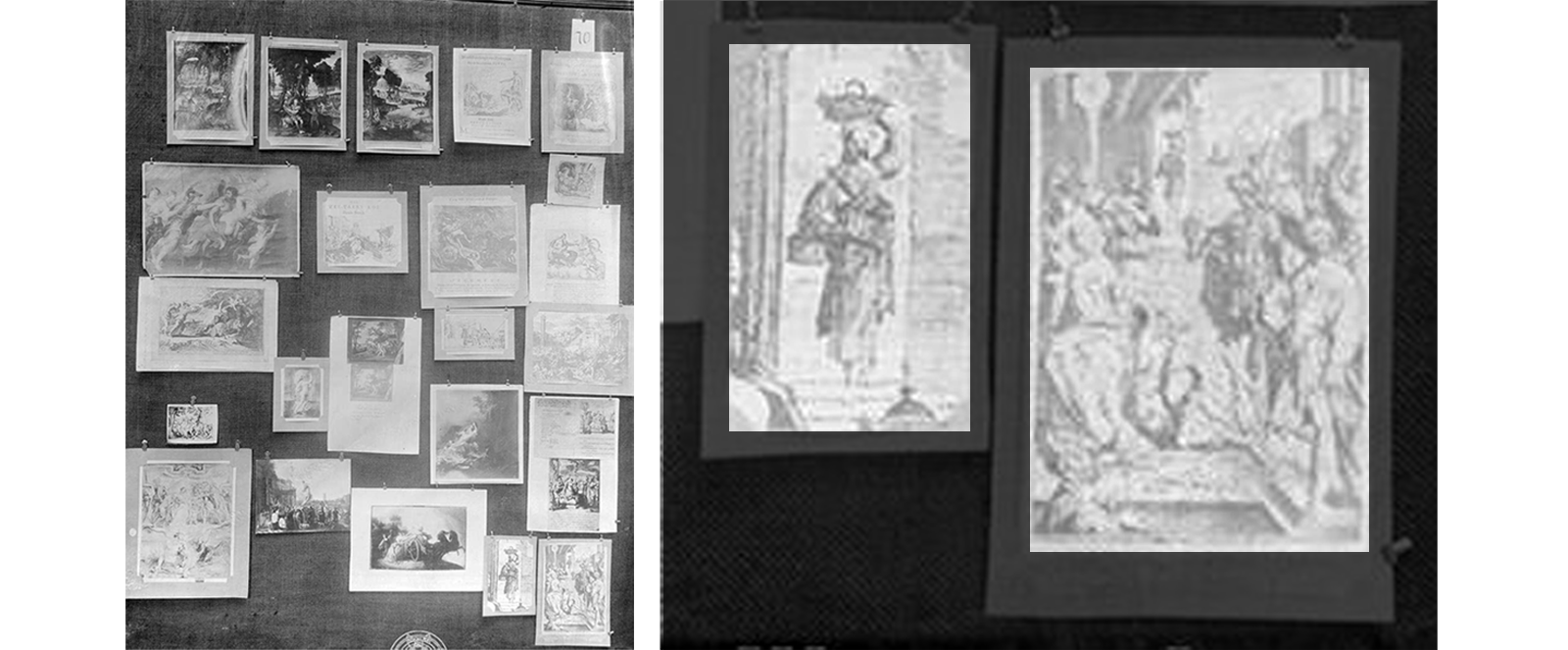
Detail from the Mnemosyne Atlas, Panel 77, Warburg Institute Archive, London.
70_24 | Crispijn van de Passe (from Jacques Bellange), Adoration of the Kings, canephore, detail, etching on copper, 1600, ca., Berlin, Staatliche Museen.
70_25 | Crispijn van de Passe (from Jacques Bellange), Adoration of the Kings, etching on copper, 1600 ca., Berlin, Staatliche Museen.
The detail in Panel 70 draws attention to one character: a canephore nymph who strides from the background of the Adoration of the Kings by Jacques Bellange (on the panel in a copy by Crispijn van de Passe) and brings the classical motif of Renaissance painting into a certain type of Nordic Baroque. The depicted Nymph, escaped from Panel 46 or Panel 47, and isolated from the etching with the act of ‘zooming in’, carries with it the afflatus of the antique. This is just like Ghirlandaio’s Nymph, demonstrating reasons for the incursion of classicism into an international style that, conditioned by official art and festivals, proceeds in the direction of the excess of theatricality in expression (see Forster, Mazzucco 2002).
Panel 72

Detail from Mnemosyne Atlas, Panel 72, Warburg Institute Archive, London.
72_2 | Rembrandt, The Blinding of Samson, oil on canvas, 1636, Frankfurt, Städelsches Kunstinstitut.
72_6 | Rembrandt, The Blinding of Samson, detail, oil on canvas, 1636, Frankfurt, Städelsches Kunstinstitut.
72_11 | Rembrandt (from Leonardo), The Last Supper, drawing, c.1635, New York, Metropolitan Museum, Robert Lehman Collection.
72_12 | Rembrandt (from Leonardo), The Last Supper, detail, drawing, c.1635, New York, Metropolitan Museum, Robert Lehman Collection.
72_16 | Rembrandt (from Leonardo), The Last Supper, detail, drawing, c.1635, New York, Metropolitan Museum, Robert Lehman Collection.
Panel 72 has two separate cases of detailed use within it. In the upper left, the panel opens with the pictures of the ‘complete’ Rembrandt’s Blinding of Samson, and the detail, extracted from that same picture, focuses on the action of one of the Philistines. In the panel’s midsection, one finds Rembrandt’s Last Supper. Two details of this drawing are then displayed in the lower-left corner, juxtaposed with a series of last suppers and convivial scenes from the Northern seventeenth century.
Panel 73
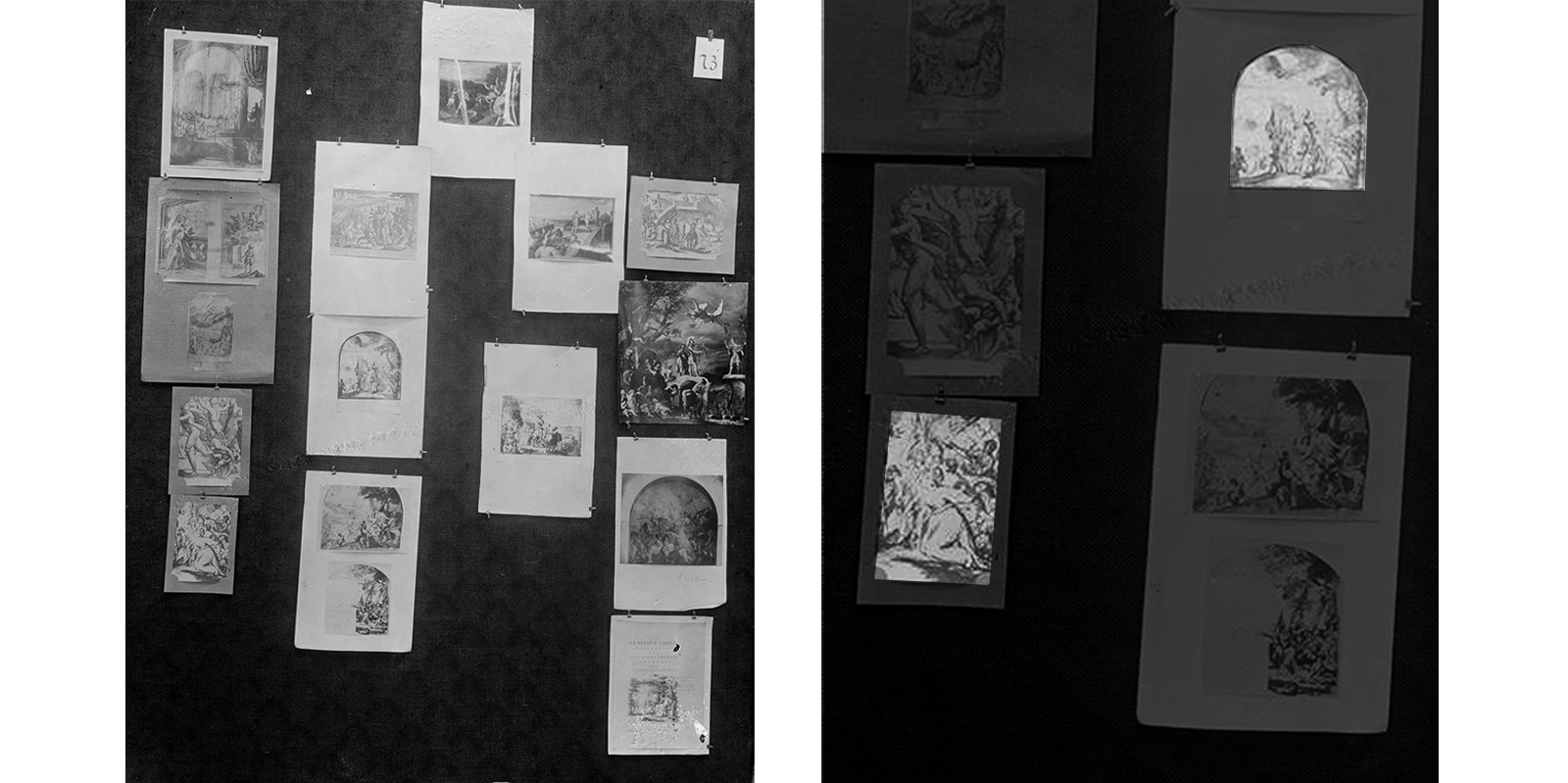
Detail from the Mnemosyne Atlas, Panel 73, Warburg Institute Archive, London.
73_10 | Jürgen Ovens, Claudius Civilis goes to the Battle of Xanten, drawing for the painting cycle in the Amsterdam Town Hall dedicated to the Batavian wars of liberation against the Romans, c.1662, Hamburger Kunsthalle, Kupferstichkabinett.
73_12 | Jürgen Ovens, particolare di donna inginocchiata from Claudius Civilis goes to the Battle of Xanten, detail, drawing for the painting cycle in the Amsterdam Town Hall dedicated to the Batavian wars of liberation against the Romans, c.1662, Hamburger Kunsthalle, Kupferstichkabinett.
“Art officiel privileges the dramatic and emotive eloquence of historical painting: Roman historical episodes substitute Ovidian mythological stories” (Seminario Mnemosyne, Panel 73). It is the case of Jürgen Ovens’ Claudius Civilis, a depiction of the historical episode for Amsterdam Town Hall, of which several preparatory drawings are displayed in the panel. The enlargement is applied to the most complete version of the drawing: the isolated detail focuses on a kneeling woman (“Frauen in der Schlacht,” as we read in Warburg’s notes about the panel) who is affixed to the left side of the plate, below the kneeling woman in Marcantonio Raimondi’s Massacre of the Innocents.
Panel 76
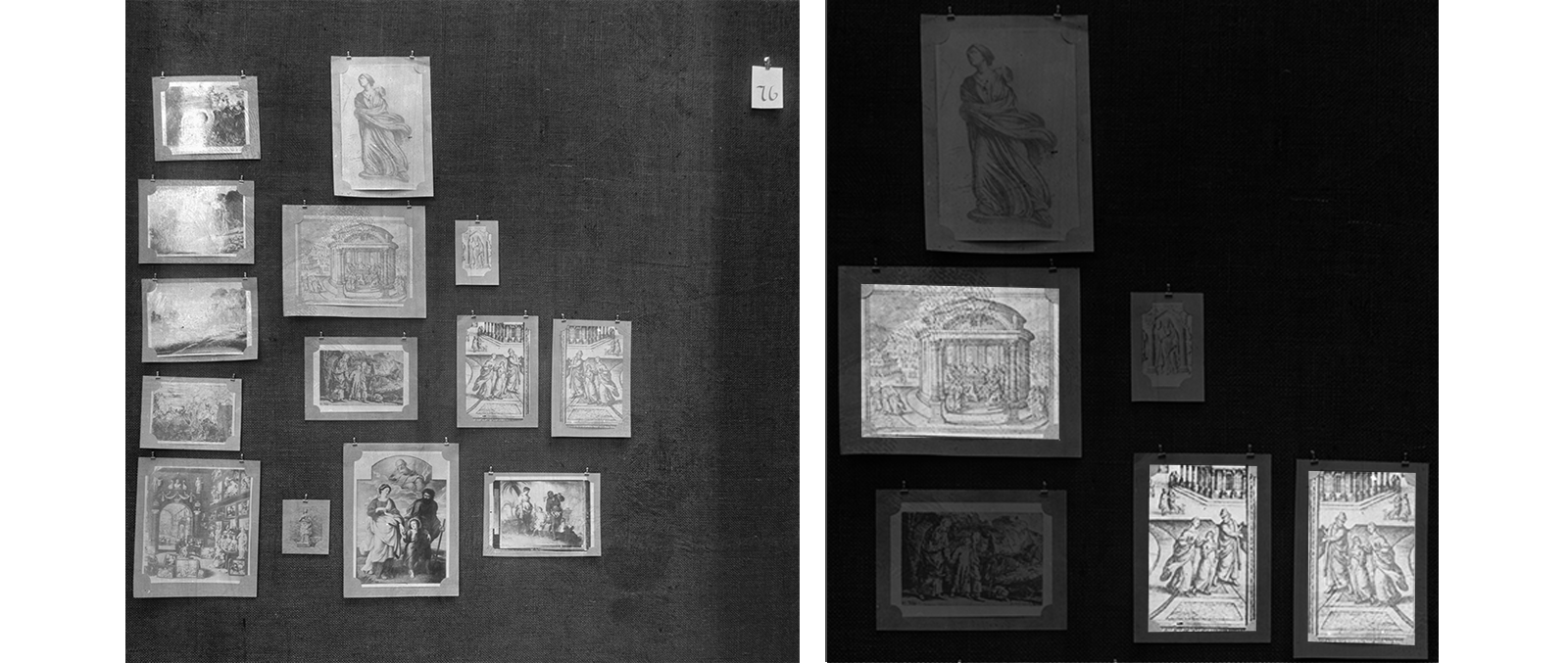
Detail from Mnemosyne Atlas, Panel 76, Warburg Institute Archive, London.
76_4 | Pieter van der Borcht, Jesus among the Doctors, illustration from Hendrick Jansen Barrefelt, Imagines et figurae Bibliorum, Jacobus Villanus (= Christoffel Plantijn), Leiden 1580-1588.
76_8 | Pieter van der Borcht, Jesus among the Doctors, Jesus returning from the temple with his parents, detail.
76_9 | Pieter van der Borcht, Jesus among the Doctors, Jesus returning from the temple with his parents, mirrored detail.
The study of the extrapolated character isolates the preconceived expressive value present in a work of art and places it in dialogue with the other images displayed in the panel, thus activating them energetically. This is the case of Panel 63, in which the detail of the Holy Family, taken from Pieter van der Borcht’s Christ among the Doctors, is useful for demonstrating with clarity the overlapping between Mary’s formal posture and Niobe’s one. From the daughter fleeing from the murderous gods, Niobe becomes the prototype of the mother concerned for her children and, consequently, a Marian figure (Seminario Mnemosyne 2018, 101). Firstly, the photograph is ‘zoomed in’, as to isolate the figures of interest for the discourse, and then, mirrored. Thus, the two images are both affixed to the Panel, revealing the persistence of the antique model regardless of the decisions individually taken by the artists and their compositional needs.
Panel 77
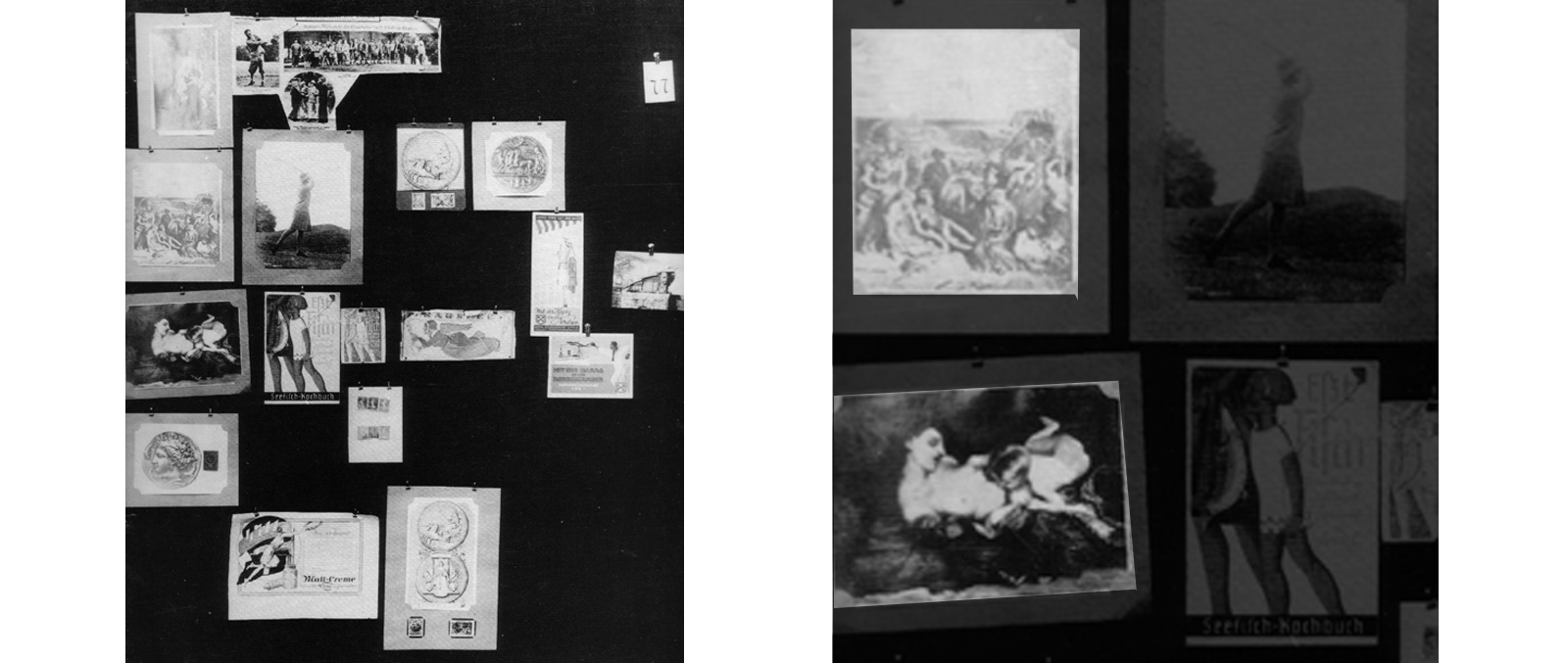
Detail from Mnemosyne Atlas, Panel 77, Warburg Institute Archive, London.
77_3 | Eugène Delacroix, The Massacre at Chios, oil on canvas (419 x 354 cm), 1824 (Paris, Musée du Louvre).
77_7 | Dead mother with her child, copy of a detail from Delacroix’s The Massacre at Chios, 1824 (Prag, Nationalgalerie).
In the painting by Delacroix, the Massacre at Chios – from which a detail is used in Panel 77, dedicated to the re-emergence of the classical in the visual culture of Warburg’s contemporaries – the dead mother by whom the child attempts, in an act of intense pathos, to be nursed, is depicted as a novel Arethusa. It is interesting to note that here, again, the detail used by Warburg is not a detail of the painting but a photo of a reproduction of the painting.
Tonal Differences in ‘Zooming’: Two Examples
How to schematise and analyse, then, ‘zoom’ recurrences in the Mnemosyne Atlas? Is it possible to identify different semantic models in the use of this device? Obviously, a taxonomy of the types of editing carried out on the Atlas is to be excluded, as such a process would contribute to the flattening of an object whose greatest epistemic power lies in its complexity. However, it might be interesting to delineate two different levels of meaning in the hermeneutics of the device through the use of two examples. We will call them, by convention: 1) first-level ‘zoom’; 2) second-level ‘zoom’.

39_11b | Sandro Botticelli, Chloris, detail from Primavera, tempera on table, 1477-1482, Firenze, Uffizi.
39_11c | Sandro Botticelli, Chloris, detail from Primavera, tempera on table, 1477-1482, Firenze, Uffizi.
1) A good example of first-level ‘zoom’ can be found in Panel 39, where, from Botticelli’s Primavera (or The Realm of Venus, according to the title Warburg proposed to the work) two details are extrapolated, focusing on the characters of Chloris and Zephyrus. The two characters are shown facing in opposite directions: they are looking at each other. Surprisingly, the intensity of their gaze is intensified to the utmost degree when their depictions are juxtaposed by Warburg, rather than within Botticelli’s painting. This action on the image could refer to a film technique named shot/countershot where one character is shown looking at another character, and then the other character is shown looking back at the first character.
The juxtaposition of the two details is furthermore functional to trace the coordinates for the evolution and the repetition of the act of catching and on the theme of metamorphosis. Just as in the Ovidian quotations in Warburg’s Sandro Botticelli essay, Chloris and Zephyrus are ascribed to Apollo and Daphne, so, in the montage of Panel 39, a range of depictions of Apollo and Daphne unfolds from the right side of the panel, starting from the ‘zooms’ on the two Botticelli characters. These paintings, from the fifteenth and sixteenth century, come from either the Italian or the Nordic Renaissance, thus testifying to a wide diffusion of the mythical theme.

39_15 | Antonio Pollaiuolo, Apollo and Daphne, tempera on panel, 1472-1473, London, National Gallery.
39_16 | Attributed to Giovanni Pietro Birago, Apollo and Daphne, miniature manuscript, last third of the fifteenth century, Wolfenbüttel, Herzog-August-Bibliothek.
39_17 | Hans von Kulmbach, Apollo and Daphne, xilography from Quattuor libri amorum, 1502, Nuremberg.
39_19 | Bernardino Luini, Apollo and Daphne (The tale of Myrrha?), fresco fragment, from Villa Pelucca in Monza, 1520-1523, Milan, Pinacoteca di Brera.

46_3 | Domenico Ghirlandaio, Birth of Saint John the Baptist, fresco, 1486, Firenze, Chiesa di Santa Maria Novella, Cappella Tornabuoni.
46_7 | Ghirlandaio’s workshop, Fruit bearer, copy of the detail from Birth of Saint John the Baptist, Pisa, Museo Civico.
2) An example of a second-level ‘zoom’ can be found in Panel 46. In the central upper part of the panel stands Domenico Ghirlandaio’s Birth of John the Baptist, whose nymph is an emblem of antiquity. Endowed with an energetic charge that is completely disruptive, compared to her pictorial context: ready to move towards new shores in the history of art. And so she does. The same nymph is to be found in the workshop copy that Warburg exhibits next to Ghirlandaio’s fresco: it is the same character from two different paintings. This is a precise choice and is an extremely effective way of demonstrating the semantic power of fragmentation. The use of workshop material can be assimilated to the use of the authorial artwork, the most authoritative and frequent study object in the ‘canonical’ art history. The use of replica elevates even further the evocative power of a figure that transcends the aestheticisation of the artistic artifact and reveals its importance throughout the tendency to be widely reproduced. The use of the ‘zoom’ in this panel has a fundamental importance in investigating the role of the artwork in Warburgian studies and the paradoxical lack of hierarchy between the piece of art and the pathetic formulae ‘trapped’ in it: “what matters in each panel is not the image itself as the idea of it” (Centanni, 2010, 20. Author’s translation). We could consider the action of ‘zooming’ in this panel as a manifesto for the anti-aestheticisation of art. This is a theme that permeated the first half of the twentieth century: one year after Warburg’s death, the film critic Béla Balázs, in his Dei Geist des Films, directly addresses Sergei Eisenstein, who, in 1926, had deplored the Hungarian’s emphasis on the figurative content of images:
Now, images ought not to symbolize ideas, but rather to fashion or stimulate them. Idea arises within us as logical consequences and not as symbols or already formulated ideograms in the image. Otherwise montage is no longer productive. It becomes a production of rebuses and riddles… (Baláz 1926, in Michaud [1998] 2004, 280).
In the critique of Eisenstein regarding the return of cinema to the primitivism of the ideogram, lies the same Warburg's syntactic approach to his Atlas. In this regard Philippe-Alain Michaud writes:
Within the panel, the fragment has no separate existence; it is the specific representation of a general theme running through every element and leading to the formation of an “overall global image effect” (Michaud [1998] 2004, 283).
Is not the role of the detail/fragment to deflagrate from within the medium of an image, making its energetic potential visible through a rupture and thus tracing the mnestic processes we carry out, looking at it? The gesture has real power, which is so intense as to obscure the artistic work. This could be referred to as an inverted use of Morelli’s detail: from the opposite pole to attributionalism, in Panel 46 the semantic power of the nymph’s fragment lies in being orphaned of an identifying origin, but at the same time being strongly identitarian by itself.
It is interesting to note that this use of ‘minor’ art as perfectly overlapping with the ‘official’ art piece (if not more authoritative for Warburg’s cultural history of art), is already discernible in the layout of the Hamburg scholar’s published articles. By analysing the editorial structure of 1902 first publication of Bildniskunst und florentinisches Bürgertum, it is interesting to note how, in the layout of the essay, the subjects are recognised by iconographic pieces of evidence. While Alinari’s photos of the described subjects – the ones that will be later featured in the Bilderatlas Mnemosyne – are located as an appendix at the end of the essay, the medals of Lorenzo, Poliziano, and Leo X, as well as Luigi Pulci in the fresco by Filippino Lippi, are mounted in the text layout. The medals represent the same characters and could be considered equal than the details extrapolated from the fresco. Once again, the cultural expression of the context is superimposable, if not even more important, in isolating the figure.
Research Agenda
The analysis of the ‘zoom’ device can be one of the ways to study the composition methodology of the Atlas: this essay is therefore intended as an initial survey of the recurrences of the use of details in Mnemosyne, as well as an attempt to take the first steps towards its theorization through the cases of Panel 39 and Panel 46. In order to continue this research, it is necessary to carry out systematic work on individual images and on the panels. The complexity of the Atlas, furthermore, makes it impossible to stop at two levels in the use of this compositional tool: without committing the sin of taxonomy, there could be more than two types of ‘zoom’ and their application could reveal new ways to the exegesis of Warburg’s corpus.
Bibliography
Sources
- Mnemosyne Atlas
Seminario Mnemosyne (ed. by), Mnemosyne Atlas, “La Rivista di Engramma”, 2012- in fieri. - Warburg, Renewal 1999
A. Warburg, The Renewal of Pagan Antiquity, edited by K.W. Forster, transl. by D. Britt, Los Angeles 1999. - Warburg [1914] 2001
A. Warburg, The Entry of the Idealising Classical Style in the Painting of the Early Renaissance, in Art History as cultural History. Warburg's Projects, ed. by R. Woodfiled, Amsterdam 2001, 7-31. - Warburg [1929] 2017
A. Warburg, Mnemosyne Atlas. Introduction (1929), trans. by M. Rampley, “La Rivista di Engramma” 142, (febbraio 2017), 11-30. - Warburg [1929] 2019
A. Warburg, Déjeuner sur l’herbe di Manet. La funzione di modello delle divinità pagane elementari in rapporto alla evoluzione del moderno sentimento della natura, a cura di M. Ghelardi, “La Rivista di Engramma” 165, (maggio 2019), 13-48.
References
- Alfieri 2010
A. Alfieri, Vita e tensione dell’immagine. Saggio su Warburg, il cinema e l’arte contemporanea, Città di Castello 2010. - Arasse [1992] 1996
D. Arasse, Le Détail. Pour une histoire rapprochée de la peinture, Paris 1996. - Calabrese [1987] 1898
O. Calabrese, L’Età neobarocca, Roma-Bari 1987. - Centanni 2010
M. Centanni, Passagenwerke per Mnemosyne: montaggio di immagini e spaziature del pensiero, da Immagini dialettiche e costellazioni tempestive. Warburg-Benjamin-Adorno, “Aisthesis” 3 (febbraio 2010), 15-30. - Centanni, De Laude 2016
M. Centanni, S. De Laude, Mnemosyne Atlas: the incunabulum. Panels exhibited at the Bibliotheca Hertziana (January 19th, 1929), “La Rivista di Engramma” 135 (aprile/maggio 2016), 23-46. - Cirlot 2017
V. Cirlot, Zwischenraum/Denkraum. Terminological Oscillations in the Introductions to the Atlas by Aby Warburg (1929) and Ernst Gombrich (1937), Eng. trans. by D. Carrillo-Rangel, “La Rivista di Engramma” 153 (febbraio 2018), 83-109. - De Laude 2014
S. De Laude (a cura di), Aby Warburg, Die römische Antike in der Werkstatt Ghirlandaios. Traccia della conferenza alla Biblioteca Hertziana di Roma (19 gennaio 1929), con una Nota al testo (e ‘agenda warburghiana’), “La Rivista di Engramma” 119 (settembre 2014), 15-38. - Forster 1976
K.W. Forster, Aby Warburg’s History of Art: Collective Memory and the Social Mediation of Images, “Daedalus” vol. 105 n.1, 169-176. - Forster 1995
K.W. Forster, Warburgs Versunkenheit, im R. Galitz, B. Reimers (hrsg. von), Aby M. Warburg. “Ekstatische Nymphe... trauernder Flussgott”. Portrait eines Geleherten, Hamburg 1995, 184-206. - Forster 1999
K.W. Forster, Introduction, in Warburg Renewal 1999, 1-75. - Gombrich 1970
E.H. Gombrich, Aby Warburg: An Intellectual Biography, London 1970. - Knape 2008
J. Knape, Les formules du pathos selon Aby M. Warburg, “La Rhétorique et les autres” 149 (mars 2008), 56-72. - Konstantopoulou 2018
D. Konstantopoulou, Arquitectura del Atlas Mnemosyne, Barcelona 2018. - Mastroianni 2000
G. Mastroianni, Il buon Dio di Aby Warburg, “Belfagor” vol. 55, n. 4 (31 luglio 2000), 413-442. - Michaud [1998] 2004
P.A. Michaud, Aby Warburg and the image in motion, Eng. trans. by S. Hawkes, New York [1998] 2004. - Pasquali [1930] 2022
G. Pasquali, A Tribute to Aby Warburg [1930], in M. Centanni (a cura di), Warburg Living Thought, trans. by E. Thomson, Vicenza 2022, 37-55. - Seminario Mnemosyne 2000
Seminario Mnemosyne, Epiphany of the “nympha gradiva”. Readings of Mnemosyne Atlas, Plate 46, trans. by E. Thomson, “La Rivista di Engramma” 3 (novembre 2000), 29-34. - Seminario Mnemosyne 2001
Seminario Mnemosyne, Incipit Mnemosyne. Readings of Mnemosyne Atlas, Panel A, trans. by E. Thomson, “La Rivista di Engramma” 9 (giugno 2001), 34-42. - Seminario Mnemosyne 2016a
Seminario Mnemosyne, Orientation: cosmology, geography, genealogy. A reading of Panel A of Mnemosyne Bilderatlas, “La Rivista di Engramma” 135 (aprile/maggio 2016), 7-21. - Seminario Mnemosyne 2016b
Seminario Mnemosyne, Mnemosyne Atlas. Un indice completo dei materiali. Didascalie delle tavole 1-79, “La Rivista di Engramma” 140 (dicembre 2016), 109-226. - Seminario Mnemosyne 2018
Seminario Mnemosyne, Maria ‘Niobe barocca’: deduzione formale e riemersione engrammatica. Appunti di lettura di Mnemosyne Atlas, Tavola 76, “La Rivista di Engramma” 157 (luglio/agosto 2018), 99-108. - Seminario Mnemosyne 2021
Seminario Mnemosyne, Il passo della Ninfa fiorentina. Lettura interpretativa di Mnemosyne Atlas, Tavola 46, “La Rivista di Engramma” 182 (giugno 2021), 51-196.
Abstract
In this contribution, Giulia Zanon investigates the use of detail as a scholarly tool in Warburg’s corpus. In the first phase of an ongoing study, the author makes a recognition of the cases in which the detail of an image in the Atlas is enlarged and juxtaposed to its original, highlighting the different visual strategies exploited by the scholar to develop and expose his research themes.
keywords | Aby Warburg; Mnemosyne; Photography; Detail.
La Redazione di Engramma è grata ai colleghi – amici e studiosi – che, seguendo la procedura peer review a doppio cieco, hanno sottoposto a lettura, revisione e giudizio questo saggio.
(v. Albo dei referee di Engramma)
The Editorial Board of Engramma is grateful to the colleagues – friends and scholars – who have double-blind peer reviewed this essay.
(cf. Albo dei referee di Engramma)
Per citare questo articolo / To cite this article: G. Zanon, Zooming Mnemosyne. Notes on the Use of Detail in the Mnemosyne Atlas, “La Rivista di Engramma” n. 191, aprile-maggio 2022, pp. 15-47 | PDF of the article